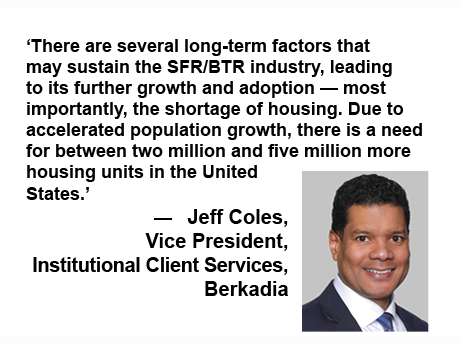By Jeff Coles, Berkadia
Over the last 15 years, even during the Great Recession, single-family rentals continued to deliver excellent returns through appreciation and rental income. As demand for the sector has increased significantly, driven by changing migration patterns, many investors are shifting their investment strategies to include single-family rental/build-to-rent homes (SFR/BTR), also referred to as built for rent (BFR) houses.
Development and Interest in SFR/BTR
Despite recessionary rumors, development is continuing, often undertaken by some of the leading developers in the for-sale single-family market. Also, institutional investors have shown an increasing interest in SFR/BTR. However, despite the fact that a handful of larger-scale players have been active in this space for the past decade, fewer of them are involved in the sector than you might think.
According to John Burns, CEO of John Burns Research and Consulting, during Berkadia’s Beyond Insights Webinar: Why Investor Interest in Single-Family Rental & Built-for-Rent Continues, there are only 12 companies that own 5,000 or more units and another 18 that own 500 or more. The number of households that rent homes isn’t much less than those who rent apartments, but the industry is still very much in its infancy, he said.
Long-Term Factors for Success
There are several long-term factors that may sustain the SFR/BTR industry, leading to its further growth and adoption — most importantly the shortage of housing. Due to accelerated population growth, there is a need for between two million and five million more housing units in the United States.
Another critical factor for the industry’s success falls under the category of shrinking housing affordability. First-time homebuyers will pay 39 percent more than first-time homebuyers did nearly 40 years ago. Millennials are beset by debt and are financially behind, due to the fallout of the Great Financial Crisis, which lead to difficulties in saving for housing.
Additionally, whether it is due to affordability or preference, we are becoming a nation of commitment-free consumers who find it more appealing to lease instead of own. Other factors working in the sector’s favor are economic growth and housing demand, however, like many other areas of the industry, economic outlook and financing feasibility are causes for concern.
Impact of Pricing and Cap Rates
Pricing and cap rates for SFR/BTR have been impacted differently by the current economy. Regarding single-family rental pricing, institutional investors decreased capital investments for the SFR sector beginning in the third quarter of 2022. Rising interest rates and concerns about declines in property prices have prompted some recalibration among SFR investors.
However, there is still investor demand in the sector with abundant capital on the sidelines. Investors are becoming more selective about acquisitions, and many want to see what the next six to 18 months will bring. In general, cap rates have risen 125 basis points over the past year, where rising interest rates and declining rent growth have had the largest impact.
The build-to-rent segment of the marketplace is better positioned than the SFR market because operators have better control over costs and execution. Housing starts have lessened due to higher interest rates, which have lessened the buyer pool for housing. As compensation, these developers have turned to BTR investors to sell their pipelines and to build BTR communities for them.
Cap rates and pricing have been affected to some extent. In some regions, BTR housing was trading at a premium to retail pricing. That has since flipped. Nationally, cap rates, which were in the low to mid-4’s, are now mid to high-5 percent range — trading slightly below conventional apartment yields. The impact of rising interest rates on cap rates could be mitigated, should we be near peak rate for the year.
In summary, the single-family rental and built-to-rent markets appear to be on a growth trajectory, with both steady and booming periods projected. The model is gaining popularity among developers, and the trend shows no signs of slowing down. This is evident in the growing volume of current and future supply and the amount of committed capital from institutional investors.
— Jeff Coles is vice president of institutional client services, Berkadia. Berkadia is a content partner of Multifamily & Affordable Housing Business. For more articles from and news about Berkadia, click here.


